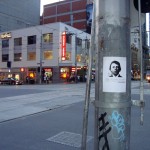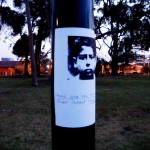For Young Dictators I worked with a group of art young artists from Melbourne. Some of them had already worked with me on a previous project entitled “Calabi-Yao Presents” for the Liverpool Biennial. Upon my arrival in Australia we quickly developed a new project. The premise was simple; we found images of infamous dictators like Joseph Stalin, Adolf Hitler and Saddam Hussein in their infancy or childhood on the internet. We paired the photograph of the child with a short title. “Have you seen this child? Please contact 0432 027 925,” the number was my temporary mobile number in Australia. The posters were cheaply xeroxed and distributed by the thousands around Melbourne. We put them up in supermarkets, on trees in parks, telephone poles and left them under windshield wipers on cars, taped them up in kindergartens etc.
Primarily, it is important to note the exact phrasing of the text. It only asks if the person reading has seen the child, nothing else. The project, in other words, plays with the person’s expectation; when he or she sees a photograph of a child, the text along with a telephone number. They add up the three and draw conclusions that are not present in the posters. The work also brings in to play how we perceive the passing of time. The majority of children are innocent, but children also grow up. And some grow up to become monsters instigating genocide. But how does that that monster relate to the existing images of their earlier innocence and our perceived innocence of childhood? Working with the project I often thought about Pinochet in London. The evil general responsible for heinous crimes against his own people was very old, sick and broken by dementia. Was this frail old, helpless man the same person responsible for the terrible actions decades earlier?
It was interesting that those who recognised the children informed us so by text message (saying something along the lines of “that child is Hitler, Stalin etc.”) Those who made their own assumptions based on image text and number called me. These people were concerned and curious and wanted to offer their support or to know more. I did my best to explain the logic of the project, break the news gently, though most of them were understandably quite upset. Still, it is interesting that they felt they had the moral right, maybe even responsibility, to tell me how they considered that the project was misleading and dishonest (many were quite rude). Also when I underlined to representatives from the media that there was nothing to support their assumptions in the posters and that they had fabricated the whole things based on expectations they became upset. Again, this is understandable since it became clear that their verification of sources remain sketchy. They also revealed that they are interested in the scandalous and do not have the means to take in something complex and more analytical.
Early one morning I got a call from Channel 10 news who wanted to do a program about the lost child. The dialogue went something along these lines:
“I understand that your son is missing and we want to help,” the reporter said.
“Have you seen the child in the picture?” I asked
“No, we want to do a report about your missing son.”
“I do not have any children, have you seen the child?”
“No, is this some kind of school prank?”
“No, it is a very serious project.”
“I do not really understand the purpose. Why did you put up all these posters?”
“We want to bring attention to the complexity of reality and of political situations and act against oversimplifications.”
(At this point there was a very long silence.)
“Why would anyone want to do that?”
“Well as a journalist I would say that it your responsibility to address complicated issues and present the opposing sides’ best arguments.”
“Look, has your son gone missing or not?”
“No.”
“Goodbye.”
(I try to explain in more detail but the reporter has already hung up)


